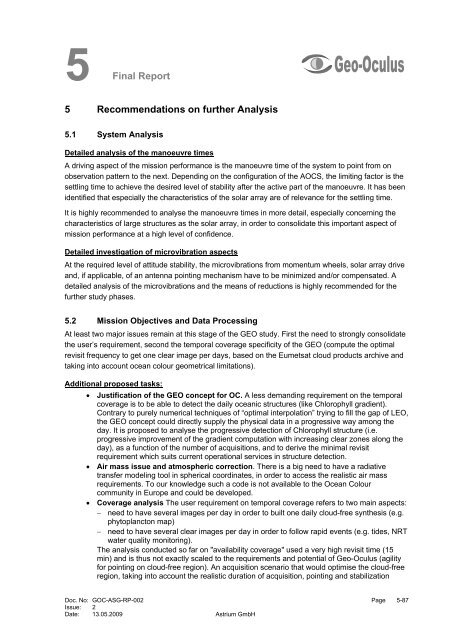4 Final Report - Emits - ESA
4 Final Report - Emits - ESA
4 Final Report - Emits - ESA
Create successful ePaper yourself
Turn your PDF publications into a flip-book with our unique Google optimized e-Paper software.
5 <strong>Final</strong><br />
<strong>Report</strong><br />
5 Recommendations on further Analysis<br />
5.1 System Analysis<br />
Detailed analysis of the manoeuvre times<br />
A driving aspect of the mission performance is the manoeuvre time of the system to point from on<br />
observation pattern to the next. Depending on the configuration of the AOCS, the limiting factor is the<br />
settling time to achieve the desired level of stability after the active part of the manoeuvre. It has been<br />
identified that especially the characteristics of the solar array are of relevance for the settling time.<br />
It is highly recommended to analyse the manoeuvre times in more detail, especially concerning the<br />
characteristics of large structures as the solar array, in order to consolidate this important aspect of<br />
mission performance at a high level of confidence.<br />
Detailed investigation of microvibration aspects<br />
At the required level of attitude stability, the microvibrations from momentum wheels, solar array drive<br />
and, if applicable, of an antenna pointing mechanism have to be minimized and/or compensated. A<br />
detailed analysis of the microvibrations and the means of reductions is highly recommended for the<br />
further study phases.<br />
5.2 Mission Objectives and Data Processing<br />
At least two major issues remain at this stage of the GEO study. First the need to strongly consolidate<br />
the user’s requirement, second the temporal coverage specificity of the GEO (compute the optimal<br />
revisit frequency to get one clear image per days, based on the Eumetsat cloud products archive and<br />
taking into account ocean colour geometrical limitations).<br />
Additional proposed tasks:<br />
• Justification of the GEO concept for OC. A less demanding requirement on the temporal<br />
coverage is to be able to detect the daily oceanic structures (like Chlorophyll gradient).<br />
Contrary to purely numerical techniques of “optimal interpolation” trying to fill the gap of LEO,<br />
the GEO concept could directly supply the physical data in a progressive way among the<br />
day. It is proposed to analyse the progressive detection of Chlorophyll structure (i.e.<br />
progressive improvement of the gradient computation with increasing clear zones along the<br />
day), as a function of the number of acquisitions, and to derive the minimal revisit<br />
requirement which suits current operational services in structure detection.<br />
• Air mass issue and atmospheric correction. There is a big need to have a radiative<br />
transfer modeling tool in spherical coordinates, in order to access the realistic air mass<br />
requirements. To our knowledge such a code is not available to the Ocean Colour<br />
community in Europe and could be developed.<br />
• Coverage analysis The user requirement on temporal coverage refers to two main aspects:<br />
− need to have several images per day in order to built one daily cloud-free synthesis (e.g.<br />
phytoplancton map)<br />
− need to have several clear images per day in order to follow rapid events (e.g. tides, NRT<br />
water quality monitoring).<br />
The analysis conducted so far on "availability coverage" used a very high revisit time (15<br />
min) and is thus not exactly scaled to the requirements and potential of Geo-Oculus (agility<br />
for pointing on cloud-free region). An acquisition scenario that would optimise the cloud-free<br />
region, taking into account the realistic duration of acquisition, pointing and stabilization<br />
Doc. No: GOC-ASG-RP-002 Page 5-87<br />
Issue: 2<br />
Date: 13.05.2009 Astrium GmbH

















